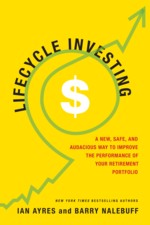

 Most investors understand that you should have more exposure to stocks when you’re young and gradually allocate more to bonds and cash as you approach retirement. In their new book, Lifecycle Investing, Ian Ayres and Barry Nalebuff point out there’s a problem with that strategy—and they offer a solution.
Most investors understand that you should have more exposure to stocks when you’re young and gradually allocate more to bonds and cash as you approach retirement. In their new book, Lifecycle Investing, Ian Ayres and Barry Nalebuff point out there’s a problem with that strategy—and they offer a solution.
Ayres and Nalebuff believe in diversifying across asset classes and agree that index funds are the best way to do this. But they argue that we must also diversify across time, something almost no one does: “Even after accounting for inflation, a typical investor has twenty or even fifty times more invested in stocks in his early sixties than he had invested in his late twenties… It’s as if your twenties and thirties didn’t really exist.”
We do take advantage of “temporal diversification” when we buy a home. When you’re in your twenties, you might save $25,000 and use it as a 10% down payment on a house, which gives you $250,000 exposure to the real estate market using 10-to-1 leverage. As you pay down your mortgage, you gradually “deleverage” as you build up equity. But even if you trade up to a bigger house a couple of times, your lifetime exposure to the real estate market stays relatively stable over three or four decades. “Homeownership is one of the very few ways that people have been willing to diversify across time,” the authors say. “This is a huge, hidden benefit of buying a home.”
Now compare that with the way most people invest for retirement. Someone in her twenties might have just a few thousand dollars invested in stocks. After paying off her mortgage, she’ll have a lot more money to invest, but by that time she may by 50 years old, and the conventional wisdom says she should be in more conservative investments. That’s the crux of the problem Ayres and Nalebuff identify: you either have lots of time and little money to take advantage of the higher returns on stocks, or you have lots of money and little time to ride out the volatility of the equity market.
By now you may have figured out Ayres and Nalebuff’s strategy: borrow to invest in stocks when you’re young. They suggest investing 200% of your savings in stocks throughout your twenties and thirties — in other words, using 2-to-1 leverage. As with a mortgage, you gradually reduce the amount of leverage as you get older, but you keep your lifetime exposure to the stock market much more consistent over time.
The authors provide reams of backtesting to compare their strategy with traditional asset allocation models. (The most common is the rule of thumb that your stocl allocation should be equal to 110 minus your age — for example, you should hold 70% in stocks age 40.) The leveraged strategy delivered much higher lifetime returns in every case, even for people who lived through the Depression or retired right after the market crash of 2008–09. If you’re comfortable with the math, you can download their original research paper to see the detailed results.
I have no doubt their numbers are accurate. But the problem with Ayres and Nalebuff’s strategy is not math, it’s human psychology. The book does discuss cases where the Lifecycle strategy would be inappropriate, and one of these is “if you would worry too much about losing money.” This is stated casually, almost as an afterthought, but it’s a fatal flaw. The strategy would work magnificently if you were in a coma and a computer were managing your portfolio. But it’s hard to imagine that more than a tiny percentage of non-comatose investors would have the stomach to carry it out.
Ayres and Nalebuff must never talk to investment advisors or they would know that just about everyone “worries too much about losing money.” Advisors repeatedly tell me that their biggest challenge is convincing their clients not to panic during market downturns. Even without leverage, most investors earn subpar returns because they can’t stick to a disciplined strategy. How would you have reacted if you’d had 200% of your savings in stocks during the 2008–09 crash? You would have been wiped out, and you probably would have been scared out of the market for a long time, maybe forever.
The other obstacle with the Lifecycle strategy is that it’s too complicated for most investors to implement on practical level. I won’t get into the details, but it involves buying on margin or using index futures, which are derivatives that allow you get market exposure without actually buying shares in an index fund. Recommending that retail investors manage their life savings this way is like suggesting that homeowners should do their own electrical work. Some will be able to do it successfully, but most will eventually get a nasty shock and give up. And a few will burn their houses down.
Filed under: Book reviews 







![]()












